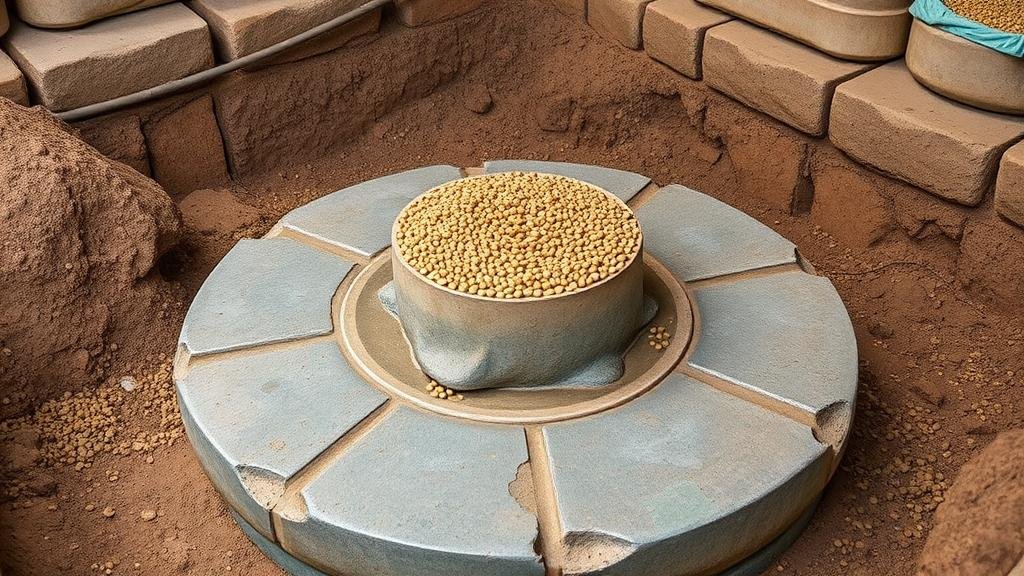Unearthing Stone Grinding Platforms Used for Grain and Seeds
Unearthing Stone Grinding Platforms Used for Grain and Seeds
Stone grinding platforms, often referred to as querns or millstones, are ancient tools used historically in various cultures to process grain and seeds. These platforms represent a significant shift in agricultural practice, allowing societies to transform raw materials into edible products through mechanized means. This article explores the historical significance, construction, operation, and archaeological importance of stone grinding platforms.
The Historical Context of Stone Grinding Platforms
Stone grinding platforms date back thousands of years, with evidence suggesting their use in Neolithic societies around 10,000 BCE. e tools emerged in response to the need for more efficient grain processing methods as agriculture became central to human civilization.
Archaeological sites across the globe, including those in Mesopotamia, the Indus Valley, and Mesoamerica, have uncovered diverse forms of grinding stones. For example, in ancient Mesopotamia, archaeologists found large, flat stones used to grind barley into flour, marking the beginning of organized food production. Each culture adapted these tools to their environmental context and available materials, demonstrating innovation in technology that complemented agricultural practices.
Construction and Design of Grinding Platforms
Stone grinding platforms typically consist of two primary components: the stationary base and the movable upper stone. This design allows for grinding action when the upper stone is rotated over the base. The materials used in construction vary, often depending on local resources, but commonly include granite, basalt, or sandstone.
The design of these grinding tools also varies; for instance, the Roman millstone often featured a central hole to insert a wooden post used for rotating. In contrast, quern stones found in ancient Canaan were more compact and symmetrical, allowing individuals to operate them manually, reflecting the social structure and labor practices of those societies.
Operation and Techniques of Grinding
The operation of stone grinding platforms is a straightforward yet labor-intensive process. Users typically place grains or seeds between the two stones. The upper stone is then turned (or manipulated by hand or foot), which grinds the grains into flour or meal. This process can be likened to the modern understanding of friction, where the mechanical action of stone against stone creates a powdery texture of the grain.
For example, studies indicate that a person could process approximately 15-20 kilograms of grain in a single day using a quern, demonstrating how these simple machines increased efficiency in food preparation. In modern depictions, adaptations of these ancient tools are still prevalent, as many artisanal bakeries utilize stone mills to produce flour, emphasizing the enduring legacy of these traditional grinding methods.
Archaeological Significance and Discoveries
Excavations of ancient settlements often reveal the presence of stone grinding platforms, which help archaeologists understand the socioeconomic status and daily lives of past cultures. For example, the excavation of a Neolithic site in Scotland unearthed several querns that suggested a shift towards larger communal agricultural practices.
Also, isotopic analysis of residues on grinding stones has provided insight into the types of grains processed. For example, studies have found traces of domesticated wheat and barley on querns in the Near East, highlighting the transition from foraging to farming. This information is crucial as it offers a clearer picture of early agricultural practices and trade networks.
Modern Applications and Sustainability
Today, contemporary artisans and bakers often gravitate towards stone grinding techniques as a sustainable method of flour production. The use of stone mills preserves the nutritional value of grains, as the gentler grinding process retains essential oils and fibers that other milling methods might destroy.
Plus, as consumers become more health-conscious, there is a growing market for whole grain and artisanal products that utilize these ancient techniques. The resurgence of interest in traditional milling methods aligns with contemporary movements toward local sourcing and sustainability in the food industry.
Conclusion: Lessons from the Past
The study of stone grinding platforms provides valuable insights not only into past agricultural practices but also into modern culinary trends. As societies continue to evolve towards sustainability and local food production, revisiting traditional methods can offer both lessons and practical applications.
In summary, stone grinding platforms have played a crucial role throughout history in the transformation of agricultural practices. By honoring age-old techniques while adapting to contemporary needs, we can ensure the continued relevance of these remarkable tools in our world.
Actionable Takeaways
- Consider experimenting with stone-ground flour in your cooking to appreciate the flavors and nutrition it offers.
- Explore local markets for artisanal bakers who use traditional stone mills.
- Engage with historical agricultural practices to understand their relevance in today’s sustainable movements.



